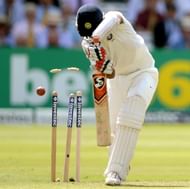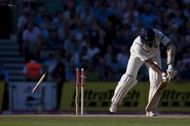Cheteshwar Pujara has had a glittering start to his career so far. Yes, he has flopped in the England tour. However the very fact that he is willing to spend time in county cricket to iron out the cracks in his game is a promising sign. But maybe Pujara is better off looking for a solution closer to home.
His flaws have majorly risen from a tendency to whip straight balls to the leg side without quite getting behind the line of the ball. This habit of his also manifests itself in another worrying symptom. He regularly plays beside the line of the ball in order to create the room for his wrists to lever through the ball. When he is playing well, his feet move in line with the delivery and he plays the balls on the off stump straight or through covers. When he is not playing well, this is what happens:
Look at his feet. The ball is on middle and off stump. His feet are on leg stump. This results in him playing inside the line which is fine if it is a hooping inswinger. On the other hand, if it is an outswinger or a straight delivery which holds its line, the image encapsulates what is likely to happen.
Comparison with Laxman
His case is strikingly similar to the Hyderabadi artist V.V.S. Laxman. Laxman always tried to get beside the ball in order to bring his wrists into play. His supremely malleable wrists then maneuvered the ball into whatever direction he wanted to put it into.
However in the 1999 Australia tour (particularly in the one dayers), Laxman went through a serious crisis in confidence as his game was literally ripped out by Glenn McGrath and co. They had a simple strategy to VVS. Outswingers pitching on middle and off stump were almost always effective because he got beside the ball and tried to stroke through it. Now if the ball moved even an inch, he was likely to miss it or nick it. This flaw was ruthlessly exposed by the Aussies and VVS soon found himself out of the Indian team.
Where Pujara can learn from VVS is in what VVS did next. He added a small shuffle as an initial trigger movement which got him more in line with the ball. Now the extra shuffle can seriously skew a batsman’s judgement of where his off stump is.To counter that ,VVS also added an small forward press which brought his bat into line with the off stump as a part of that initial shuffle. This enabled him to leave deliveries outside off with ease. Now, the strategy of bowling outswingers on middle and off started proving counter productive since it opened up the onside for the Hyderabadi artist.
In 2001, the Australians learnt that the hard way. He got himself into such beautiful positions that he was able to play the same delivery on off stump through mid wicket as well as extra cover. His game against the inswingers had always been stellar with his great wrists coming into play. The only possible flaw against this technique was when he was up against genuine pace (the likes of Lee and Akhtar) and the length was really full (even full tosses at time).
His shuffle meant that he took a small bit of time to get into line and by the time he was in position, the ball was below his line of sight (VVS was a tall man). However this problem occured only against genuine pace and mostly he dealt with it by pre-empting the bowler.
Now Pujara can learn from this. If he can tweak his initial position and footwork, he would be getting more into the line of the delivery and he would stop missing those awkard straightening deliveries. When that happens , you can be sure the ChePu will start piling them on again. For now, Cheteshwar, please seek out the Hyderabadi artist residing in your home country.
Follow IPL Auction 2025 Live Updates, News & Biddings at Sportskeeda. Get the fastest updates on Mega-Auction and cricket news


